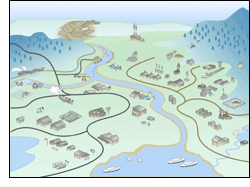Tribal Environmental Law:
 Tribal
Court Clearinghouse: a project of the Tribal Law and Policy Institute describes environmental review codes as follows:
Tribal
Court Clearinghouse: a project of the Tribal Law and Policy Institute describes environmental review codes as follows:www.tribal-institute.org/codes/part_nine.htm
Tribal Legal Code Project: Environmental Review Codes
What is the purpose of an environmental review code?
Environmental review codes can facilitate tribal protection of members' health and safety and ensure suitable land, clean water and air for future generations, and preserve a traditional land based way of life. To these ends environmental review codes:
- provide information thorough data collection and dissemination of information to the tribe about development projects
to inform decision making by the tribe on specific projects;
- coordinate new development with ongoing land use planning by the tribe;
- coordinate related tribal programs and clarify areas where codes overlap or leave gaps that affect the environment e.g.
land use plans, water quality regulations, fish and wildlife protections, building codes, solid waste codes, preservation
of historic sites, preservation of spiritual sites, cemetery preservation;
- facilitate public participation in planning and development decisions through public hearings and comments on proposed projects;
- provide procedures for tribes to monitor ongoing development projects for consistency with permits and plans;
- coordinate tribal compliance with federal environmental laws as they apply to tribal lands, e.g. under NEPA, ESA, and CWA § 404, and provide a framework for compliance with both federal and tribal environmental requirements.
Click HERE for the entire description of environmental review codes by the Tribal Law and Policy Institute.
Implementing Solutions:
Please submit your experiences (successes/challenges) and tribal-specific documents to share on our website using the attached form.Download Form [doc]
Many tribes have developed environmental codes that are available online. The National Indian Law Library of the Native American Rights Fund provides a custom search at www.narf.org/nill/triballaw/codes.htm
Resources:
ITEP's Tribal Compliance and Enforcement Training Resources January 2013 [doc]DRAFT Implementing Institutional Controls in Indian Country [pdf]
Example Codes:
White Mountain Apache Environmental Code [doc]
Ely Shoshone Toxic Cleanup Housing Ordinance: Cleanup of Toxic Contamination from Illegal Drug Manufacture [pdf]
Yurok Tribal Underground Storage Tank Ordinance [doc]
Ho-Chunk Nation Code: Personnel, Employment and Labor Code, Occupational Safety and Health Program Act of 2002, Hazard Communication [pdf]
Websites:
Tribal Law and Policy Institute Environmental Law Resource Information:www.tribal-institute.org/lists/environ.htm
National Indian Law Library of the Native American Rights Fund – How to Find Tribal Codes and Ordinances:
www.narf.org/nill/index.htm
National Indian Justice Center Links to Tribal Codes & Constitution Links:
www.nijc.org/resources.html
National Tribe Resource Center for Tribal Courts and Justice Systems Training and Technical Assistance:
www.naicja.org/training/ntjrc/services
ITEP's EEOP Environmental Resources: Tribal Ordinance/Code Development Resources:
www7.nau.edu/itep/main/eeop/Resources/res_tocd
Related Pages:
BrownfieldsContaminated Sites
Federal Facilities
Resource Conservation & Recovery Act
Superfund CERCLA
For more information, please contact:
Jennifer Williams, Alaska Program Coordinator, Sr.
Tel: 928/523-0673
Email: Jennifer.Williams@nau.edu
Tel: 928/523-0673
Email: Jennifer.Williams@nau.edu
Last updated: July 10, 2015
